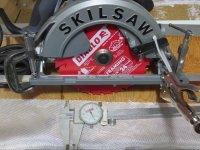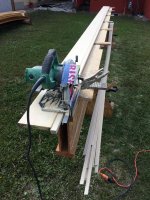Just an update, as I know many new builders, and Old are waiting for warm weather to start cutting strips !
I picked up a great bargain on a Skil Brand Skilsaw, and so I set it up for cutting strips. It's a 15 amp saw (good !), and a magnesium base, that takes little effort to push the saw down a plank ! The base seems ridged, unlike a Dewalt saw I checked out.There was more play on the Dewalt than I was comfortable with. Pass on the Dewalt for that reason !
After trying my set up I decided I used too thin of an aluminum angle ! I recommend a 1/8" thick 3/4" x 3/4" x 12-15" piece. I always trim one side of the angle down to 5/8". This insures plenty of clearance on the cleats that support the planks . I tried to Cheat and use a thinner aluminum angle, that I had, it was too flimsy ! A mistake, I hope others don't make my mistake.
Use a decent caliper and accurately measure clearances between the blade and fence, for smoothly cut strips ! No need to plane to thickness !
Once I set up a saw, I hate to change, unless it leaves saw marks on the strips !
I will use this saw to cut gunnels, and so I set it to cut 3/8" Ash strips.
I picked up a great bargain on a Skil Brand Skilsaw, and so I set it up for cutting strips. It's a 15 amp saw (good !), and a magnesium base, that takes little effort to push the saw down a plank ! The base seems ridged, unlike a Dewalt saw I checked out.There was more play on the Dewalt than I was comfortable with. Pass on the Dewalt for that reason !
After trying my set up I decided I used too thin of an aluminum angle ! I recommend a 1/8" thick 3/4" x 3/4" x 12-15" piece. I always trim one side of the angle down to 5/8". This insures plenty of clearance on the cleats that support the planks . I tried to Cheat and use a thinner aluminum angle, that I had, it was too flimsy ! A mistake, I hope others don't make my mistake.
Use a decent caliper and accurately measure clearances between the blade and fence, for smoothly cut strips ! No need to plane to thickness !
Once I set up a saw, I hate to change, unless it leaves saw marks on the strips !
I will use this saw to cut gunnels, and so I set it to cut 3/8" Ash strips.
Last edited:




